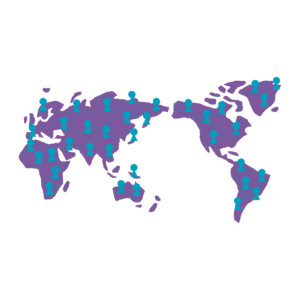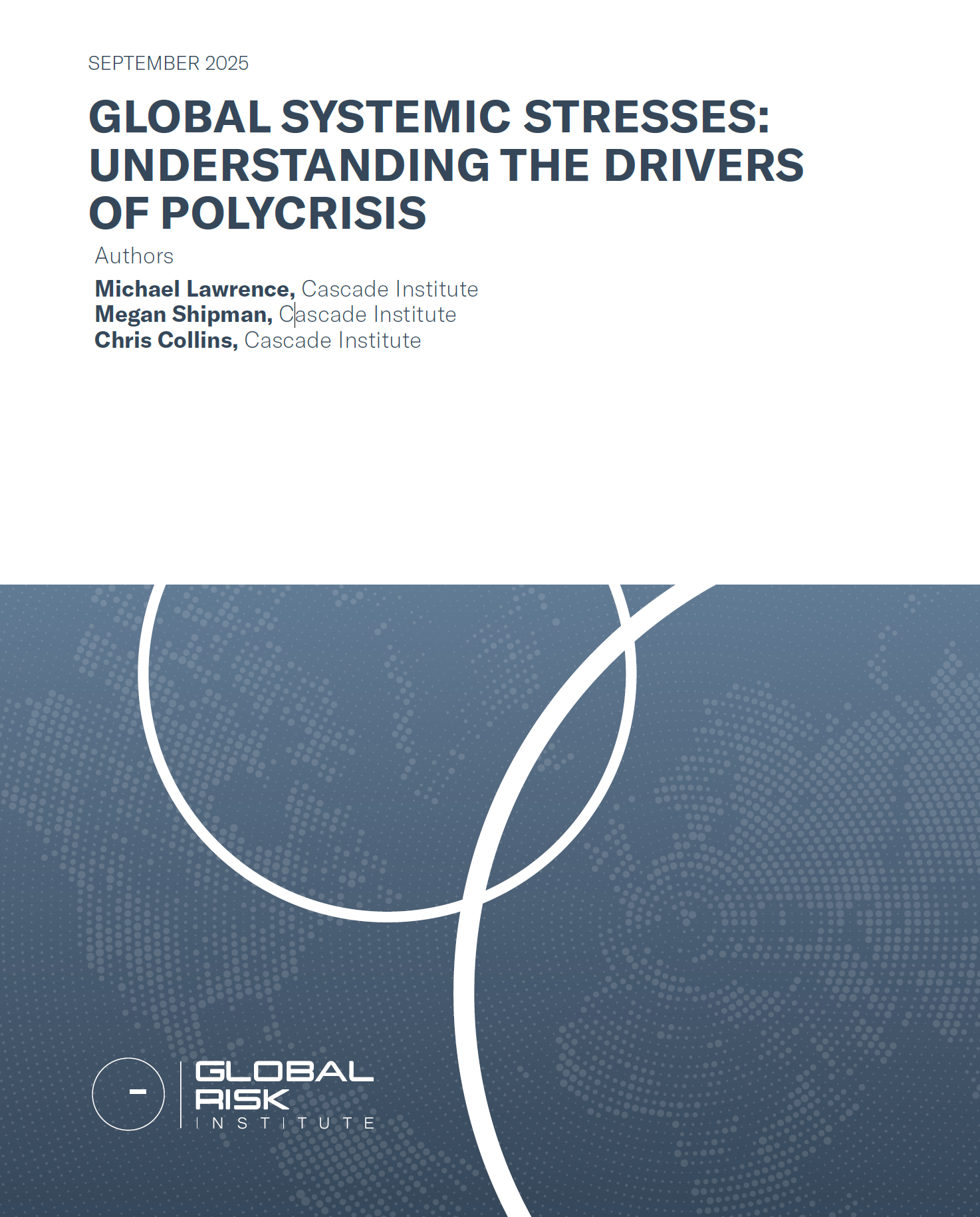Global stresses are long-term processes that weaken the resilience of critical global systems by increasing pressures, sharpening contradictions, and expanding vulnerabilities. As explained in the Stress-Trigger-Crisis Model, these stresses make systems more vulnerable to trigger events that push them into crisis.
The Cascade Institute’s Polycrisis program tracks fourteen global systemic stresses active in the world today. These global systemic stresses create systemic risks, contribute to the present polycrisis, and are likely to generate additional crises in the near future.
By focusing on stresses, rather than just triggers, this analysis enables better foresight and strategic planning.
Key insights
- Stresses are trackable: Unlike unpredictable triggers, stresses unfold over years or decades and can be monitored using indicators.
- Stresses weaken resilience: They erode a system’s ability to recover from shocks, increasing the likelihood of cascading failures.
- Crises are becoming systemic: When triggers interact with accumulated stresses, systems shift into disequilibrium (volatile, unpredictable, and potentially harmful states).
- Stresses come in three types: These include pressures (e.g., resource depletion), contradictions (e.g., market externalities), and vulnerabilities (e.g., financial interconnectedness).
Fourteen global systemic stresses

Climate heating: Anthropogenic greenhouse gas emissions are increasing the Earth’s energy imbalance and raising average surface temperatures at an accelerating rate.
A hotter climate:
- Generates increasingly frequent and severe weather events, including major storms, droughts, wildfires, floods, heatwaves, and cold snaps.
- Changes regional climatic conditions, including temperature, precipitation, weather, and seasonal patterns.
- Raises sea levels and thereby threatens coastal areas, including most of the world’s megacities.
- Risks breaching tipping points that drastically and irreversibly change key elements and behaviours of the Earth system.

Ecological degradation: Human activities, including resource extraction, agriculture, and urbanization, are disrupting ecosystems around the world.
These pressures are:
- Diminishing biodiversity and increasing species extinction rates in ways that disintegrate—and may even collapse—complex ecosystems around the world.
- Reducing critical ecosystem services such as water filtration, carbon sequestration, and nitrogen fixation.
- Jeopardizing keystone species (such as pollinators) in ways that will propel further ecological decline.

Toxicity: Humans are dispersing toxic industrial chemicals (“forever chemicals”) such as PFAs (Teflon), lead, mercury, glyphosate (herbicide), fluorocarbons, and microplastics across the planet.
These chemicals:
- Are now ubiquitous in human and animal bodies, where they affect the immune and endocrine systems, as well as the liver, brain, thyroid, and possibly other organs.
- Appear to be reducing fertility, increasing cancer risks, inhibiting physical and cognitive development, altering metabolism, and promoting antibiotic resistance, with unknown long-term consequences.
- Threaten organisms worldwide, contributing to ecological degradation and, through their persistence, worsening environmental conditions indefinitely.

Zoonotic disease transfer: Climatic and ecological change, human encroachment into animal habitats, and factory farming are increasing contact and pathogen transfer between humans and (often unfamiliar) animals.
This widening encounter:
- Strains and exceeds the ability of health systems to identify, monitor, contain, treat, and eradicate novel diseases.
- Generates new pandemic risks that could spread rapidly through global transportation networks and threaten to overwhelm healthcare systems.
- Increases the antimicrobial resistance of pathogens, thereby threatening food production with recurring and novel outbreaks of disease.

Demographic divergence: The composition of the human population is changing profoundly around the world but moving in different directions in the Global North and the Global South.
These trends include:
- Continued growth of the overall human population.
- Aging populations in the Global North that strain pension funds, healthcare, welfare, and other public services while diminishing the workforce.
- Growing youth populations in the Global South that find scant economic opportunity and strain public services and governance.
- Increasing migration from the Global South (where labour supply is increasing) to the Global North (where labour demand is increasing).

Concentrated industrial food production: The concentration of global food production in a few species, in specialized countries, and in corporate ownership creates significant vulnerabilities to failures.
Industrial food production:
- Limits food production to a small number of monocrops that are susceptible to blights.
- Renders many countries dependent on imports of food and food production inputs (such as machinery, fertilizer, and herbicides), leaving them vulnerable to food trade disruptions.
- Undermines, through the intensive use of fossil fuels, fertilizers, and pesticides, the ecological and climatic conditions on which production ultimately depends.

Changing energy supply: Efforts to transition away from fossil fuels to clean energy sources aspire to transform the global energy system but face significant challenges.
These challenges include:
- The limited power density of clean energy sources in comparison to fossil fuels.
- The continued entrenchment of fossil fuels in all aspects of life, especially transportation, infrastructure, agriculture, economic production, and, via lobbying, political processes.
- The difficulty of substituting fossil fuels out of the mass production of steel, cement, ammonia, and plastic, all of which are essential for a clean energy transition.
- Bottlenecks and scarcities of key material inputs, such as the rare earth minerals required for solar panels, wind turbines, and batteries, as well as fossil fuels.

Financial interconnectedness: The dense interactions among financial actors create opaque vulnerabilities to cascading failure in the financial system.
Connectivity creates systemic risk by:
- Enabling contagion across different financial markets so that turmoil in one area can spread to all sectors of economic activity.
- Fostering a herd mentality that generates and accelerates bank runs, asset devaluations, lending freezes, and forced liquidations.
- Under-regulating a growing range of non-bank financial intermediaries (NBFIs) that are responsible for a growing share of high-leverage and non-transparent financial activity.
- Incentivizing excessive risk-taking by actors considered “too big to fail,” and those invested in them.

Economic headwinds: Several trends constrain economic activity and push the global economy towards stagnation and depression.
These trends include:
- A paradigm shift from global economic integration in pursuit of efficiency to fragmented geo-economic arrangements oriented towards political goals.
- The proliferation of nationalist and protectionist measures such as tariffs, industrial policies, and investment restrictions.
- Under-investment in productive activities, often due to excessive savings, consumption, debt (both public and private), or austerity.
- Resource scarcities, bottlenecks, and choke points in global supply chains that are increasingly activated by conflict and climate change.

Economic inequality: Growing disparities of income and wealth jeopardize economic productivity and generate mounting political and social harms.
Inequality persists and grows because:
- Wealthy actors are disproportionately able to shape policies and economic conditions in ways that preserve and augment their power.
- Neoliberal policies have disempowered labour, fostering a decline in its real wages and living standards.
- Economic precarity fuels political backlash that threatens the social stability on which economic growth depends.

Ideological fragmentation and polarization: The combination of social media technologies with deepening ideological conflict is overloading human cognition, eroding shared meaning, and dividing people into antagonistic groups.
The resulting fragmentation and polarization:
- Exacerbate social strife and inhibit collective action on shared problems.
- Enable the rapid and far-reaching spread of misinformation, disinformation, and extremist ideologies.
- Create echo chambers in separate and opposed “truth bubbles,” across which people disagree over basic facts and cannot communicate constructively.
- Harden in-group/out-group boundaries in an escalating spiral of mutual hostility.

Political-institutional decay: Governing institutions are losing the ability (and often the willingness) to mobilize concerted action and address collective problems.
Decay stems from, and reinforces:
- Public dissatisfaction with governing elites and declining trust in government institutions, often fuelled by foreign interference, disinformation, and ideological conflicts.
- Authoritarian practices that worsen governance by weakening the rule of law, dismantling checks and balances on power, and intensifying repression.
- A nationalist turn inward towards a narrow conception of self-interest that eschews the multilateral cooperation necessary to solve supra-national problems (including those that drive the inward turn).

Great power hegemonic transition: The current world order features an unstable disjunction between its established, Western-led institutional order and its changing distribution of military, economic, and technological capabilities, fostering conflict and uncertainty over its future.
This transition manifests in:
- Growing tensions between great powers as they pursue differing visions of world order, increasing the risk of war between them.
- The resurgence of armed conflict around the world amidst the breakdown of longstanding institutions of conflict management.
- The decline of multilateral cooperation and the weakening capacity of international institutions to manage global problems.

Propagation of artificial intelligence: Artificial intelligence is developing rapidly, outpacing efforts to regulate its growth and promising upheavals in all areas of life and work.
Its major risks include:
- Displacing blue- and white-collar workers through the automation of economic production.
- Accelerating the spread of increasingly sophisticated forms of misinformation and disinformation.
- Generating novel and intensified threats to security via cyberattacks, espionage, mass surveillance, automated weaponry, and sabotage of critical infrastructure.

